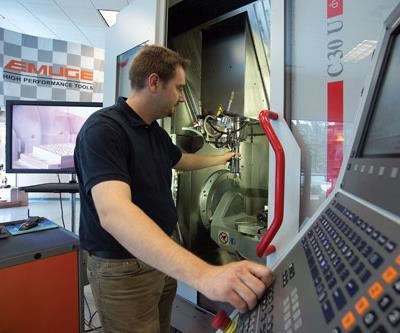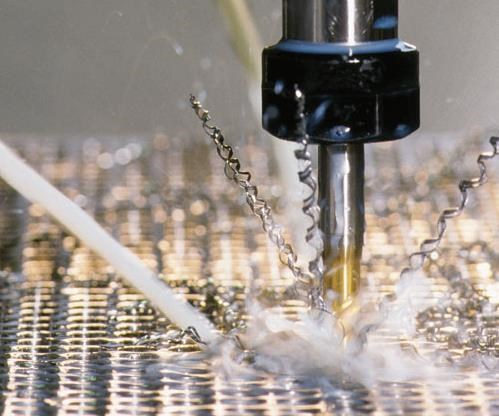Tapping titanium alloys such as titanium 6Al4V is more difficult than tapping most alloyed materials, but certainly doable with appropriate taps and techniques. Titanium is both strong and lightweight, making it a very appealing metal for applications in aerospace, medical and other industries. However, the unusual properties of titanium make it challenging for manufacturing engineers who are planning machining processes for components in this material.
For example, titanium does not conduct heat well. When machining titanium, heat tends to build up on the faces and edges of cutting tools instead of dissipating through the part and machine structure. This is particularly true when tapping because there is more contact between the interior surface of the hole and the tap than there is between a workpiece and a drill, end mill or other tool. This retained heat can result in chipped cutting edges and reduced tap life. Also, titanium’s fairly low modulus of elasticity gives it “springiness,” so the workpiece tends to “close in” on the tap. This effect causes galling and tearing of the threads. It also increases torque on the tap and shortens its life.
For best results when tapping titanium, use high quality taps, mount them in modern tap holders and apply appropriate speeds on a machine that has good feed control.
Use Proper Speeds
Tapping speed is critical for cutting threads in titanium alloys. Inadequate or excessive speed will result in tap failure and/or shortened tap life. We recommend a tapping speed of 10 to 13 sfpm for both turning into and exiting the tapped hole. While slower than that for tapping most other materials, this range has been proven to provide the most consistent tap life and greatest productivity.
Use the Right Tapping Fluid
Tapping fluid (coolant/lubricant) will affect tap life. Although the same fluid used for other operations in titanium is an option for tapping, this fluid may not necessarily produce the desired thread quality and tap life. We recommend quality emulsions with a higher percentage of oil or, better yet, a tapping oil. In tapping, the lubricating properties of the fluid are generally more important than cooling because taps run at relatively slow speeds and do not remove large volumes of material. Lubricity helps extend tap life and protect the surface finish of the threads.
Tapping titanium alloys that are exceptionally difficult to machine may require a tapping paste with extreme pressure additives. These additives are designed to adhere to cutting surfaces despite the high machining forces generated in the tool/workpiece interface. The drawback to tapping paste is that it must be applied manually and not automatically through the machine’s coolant system.
Use a Modern CNC Machine
Although any machines capable of cutting titanium alloys should be able to tap these materials effectively, modern CNC machines are best suited for tapping titanium. Generally, these newer machines offer rigid (synchronous) tapping cycles.
Older CNC units often lack this feature. However, machines with older controls can be used to tap titanium, but a tension/compression style tap holder must be used instead of a rigid collet-type tap holder. The tension/compression holder compensates for the vagaries in the feed of the tap, which occur because axis control is not as fine on these older controls.
Use the Best Taps
Many tap manufacturers have a product line specifically designed for titanium or other tough alloys. These products generally use spiral flutes because they tend to lift chips up and out of the hole, thus keeping the flutes from becoming packed with chips. Chip packing is the leading cause of tap failure and problems with thread quality. Other design features from various suppliers are proprietary.
Emuge has two tap designs for cutting threads in titanium alloys. Through-hole applications call for the Rekord C-Ti series tap. Taps in this series have an 8- to 10-degree, left-hand spiral flute designed for right-hand cutting in through holes. This is combined with a four- to five-thread chamfer, in addition to face rake and relief characteristics for cutting the tough alloy material. Blind-hole applications call for the Rekord D-Ti series. Taps in this series have a 10- to 15-degree, right-hand spiral flute designed for right-hand threads. This is combined with a two- to three-thread chamfer as well as appropriate face rake and relief characteristics. Note that blind-hole taps are designed to extract chips out the top of the hole, whereas through-hole taps are designed to push chips through the bottom of the hole. Both designs are intended to prevent chips from packing in the tap flutes.
Use a Modern Tap Holder
Taps are especially vulnerable to vibrations, which can degrade thread quality and reduce tap life. For this reason, high-performance tap holders should be used to provide a rigid setup. We recommend rigid/synchronous tapping cycles with Softsynchro collet-type tap holders. Rigid/synchronous tapping cycles are possible on modern CNC machining centers because the rotation of the spindle can be synchronized accurately with the tap feed axis, both in a clockwise and counterclockwise direction. This capability makes it possible to produce threads without length compensation in the tap. Softsynchro type holders, which were developed by Emuge and are offered by a number of suppliers, were designed to compensate for the slight synchronization errors that can occur with even the best CNC equipment.
For CNC machines without a rigid tapping cycle, use a high-quality tap holder with an initial hard start feature. This design incorporates a tensioning mechanism that enables the tap to cut only after a certain axial pressure develops. Essentially, the tap “stalls” momentarily until it can overcome the built-in resistance. This hard-start feature ensures that the tap will start cutting at the same position every time. Without this feature, compression of the tap within the holder would grow as the tap becomes dull. Excessive compression +of the tap prevents it from cutting threads to full depth. Because the toughness of titanium makes any cutting tool dull more quickly, the risk of producing bad threads is greater without the hard-start feature in the tap holder.
Likewise, be sure the CNC is programmed for the proper feed to tap at the optimum surface speed. Holders with a hard-start feature are also recommended for tapping on a manual machine.
Hold on to Your Work
For the highest accuracy and repeatability, examine your clamping application to ensure your workholding system can adequately hold on to the part. This advice is especially important for both low-volume job shops and high-volume automotive production plants, which are more likely than ever to encounter jobs involving titanium workpieces. Many of these workpieces will have thin walls and complex features that are conducive to vibrations. In these applications, rigid setups benefit every machining operation, including tapping. For these reasons, we recommend working closely with your workholding solution providers so they understand your particular challenges. Doing so will help avoid miscommunication and reduce overall project costs.
Plan Ahead for Tap Equipment
Requirements
Tap life depends upon many factors, including the machine’s capability, the precision of the feed control, the quality of tap holders, the specific grade of titanium alloy, the type of coolant or lubricant and so on. Optimizing all of these factors will ensure that tapping operations are economical and productive.
When tapping titanium, a good rule of thumb is this: For a hole twice as deep as its diameter, you can expect 250-500 holes from each tap. Keep good records to monitor tap life. (Of course, it is always important to start a new job with new taps, regardless of the material you are tapping.) An unexpected change in tap life may indicate that a key variable must be adjusted. Problems with a tapping operation may also indicate a condition that has negative effects on other operations.
A Final Comment
Because titanium workpieces are often costly, representing both a considerable investment in raw material and substantial value-added processing, care with tapping is well worth the effort.


























.png;maxWidth=300;quality=90)








